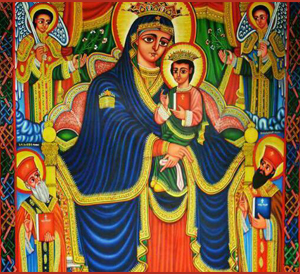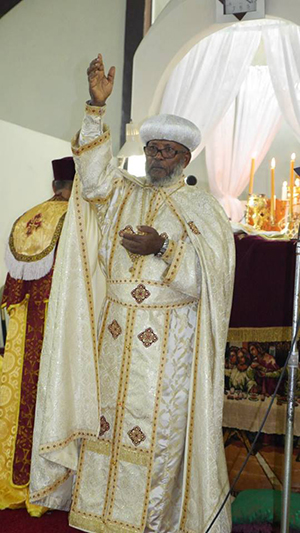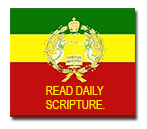
Caribbean and Latin America.



In the nineteen forties and fifties Pan Africanism was generally on the rise in the Caribbean. Its leaders like Marcus Garvey and George Padmore among others were not contended with accepting the degrading conditions prevailing at that time. Some of them took to the Bible as their daily conversations and as a tool of analysis and interpretation of their human conditions. They were fed up with the colonial spiritual leaders who condone the system of oppression, slavery, and colonialism. When confronted with the question of their identity, they would have recourse to the Holy Bible which states that man was made in the image and likeness of God. They, therefore, determined that they ought not to adopt the image of their colonial masters.
Marcus Garvey in one of his many writing stated clearly, that the time had come for the Africans to worship their God through the spectacles of Ethiopia, and made reference to Psalm 68 verse31 which states' Princes shall come out of Egypt; Ethiopia shall soon stretch forth their hands unto God.
Having used this text as their preaching David Modest, assisted by Garnet Springer and others went throughout the country spreading the word. They were able to attract into Trinidad a Nigerian National, David Quartney Arthur, also called Mar Lukas who came as Archbishop of the Ethiopian Coptic Church. After a few months, it was realized that he did not belong to the Ethiopian Orthodox Church and the local committee in Trinidad decided to send Garnet Springer along with Mar Lukas to Ethiopia to make representations to Emperor Haile Selassie 1 and the Patriarch of the day. (Abuna Basilios)
The Emperor and the Church, having listened to the demands of the delegation decided to send to Trinidad Abba Gebre Eyesus Meshesha a monk accompanied by Ato Abera Jembere as an interpreter. They landed in Trinidad on the 16 th December 1952. By this act, Trinidad became the first place outside of Ethiopia and Jerusalem where the Ethiopian OrthodoxTewahedo Church was established. After some months Mar Lukas left the Church, thereafter, Abba Meshesha remained as a Missionary and Ato Jembere returned to Ethiopia.
Under the leadership of Abba Meshesha, branches of the church were opened all over the country as well as in Tobago. The Church was also introduced in Guyana as well. At present there are nine parishes in Trinidad and Tobago. There are also four Parishes in Guyana.
The Church in Trinidad and Tobago was incorporated by an Act of Parliament in 1956.
In 1959 the Acting Patriarch Abuna Theophilos visited the Caribbean and ordained nationals of Trinidad and Tobago as members of the clergy to assist Abba Meshesha in the performance of his duties. He returned to Trinidad in 1973 as Patriarch. In 1966 the Emperor of Ethiopia, Haile Selassie the First paid a state visit to Trinidad and Tobago. The Government of Trinidad and Tobago gave to the Church a Deed of Gift of three acres of state land at Beetham Gardens in the city of Port of Spain, to build a cathedral, an objective which has not yet been realized for more reason than one. The Emperor laid the cornerstone on this site as well as on the church's property on Darrel Spring Road Tobago.
In 1972 Abba Meshesha was recalled to Ethiopia and was consecrated the first Bishop of the Western Hemisphere, (His Grace Abuna Athanasius). On his return to Trinidad, he was accompanied by Abba Wolde Gabriel Wolde Selassie and Abba Haddis Gessesse, now deceased. From 1952 to present many Ethiopian Fathers came and served the church in the Caribbean. Their main duties were to teach the people the doctrine, traditions and the language of the church.
In the seventies and eighties, early learning centers were introduced in Trinidad and Tobago. At present, there is one in San Fernando, Trinidad industrial capital.
A new building is almost completed at the Archdiocesan headquarters in Trinidad, which will be used for accommodation for visiting members of the clergy, an early childhood learning centre and also a theological school for the clergies and members.
In 1970 Abba Like Mariam Mandefro (Abuna Ysehaq) who was assigned to North America established a branch of the Church in Jamaica and did the same in Bermuda in 1975. In 1979 he became the second Archbishop in the Western Hemisphere and replace Abuna Athanasius who had been recalled to Ethiopia.
In 1992 a new Patriarch was elected in the person of His Holiness Abuna Paulos. The Holy Synod decreed the renaming of the Archdiocese. There was now the Archdiocese of the Caribbean and Latin America headed by Archbishop Abuna Gabriel.
As a result of this action, Abba Wolde Gabriel Wolde Selassie was recalled to Ethiopia in 1993 and was consecrated Bishop of the Caribbean and Latin America.
Upon his return to Trinidad, Abuna Gabriel returned to Ethiopia. In 1995 His Holiness Abuna Paulos visited Trinidad in 1995 His Grace Abuna Thaddaeus was elevated to the position of Archbishop. Under His guidance and stewardship, the church was introduced into Barbados in 1995, in Martinique in2004, in Guadeloupe in 2005, and Antigua and Barbuda in 2009.
In Trinidad two new Churches were erected, Holy Trinity parish in Port of Spain and St. Peter's parish in San Fernando. The St. Gabriel Church was also built in Guyana. His Grace Abuna Thaddaeus has served the people of the Caribbean for almost forty-seven years. It should be highlighted that His Grace Abuna Thaddaeus, has for the past six years been ably assisted by Archmandrite Gebre Eyesus Wolde Samuel and there at present over forty members of the local clergy in the Archdiocese lending their support to the Archbishop in administering to the faithful.
Several challenges are facing Our Church in the Caribbean and Latin America. Even though we have baptized thousands of persons, it faces languages, cultural and traditional barriers. The church of Ethiopia came to these shores intending to give to her people that pure doctrine and tradition which was preserved in a free Ethiopia for thousands of years. However the people in the Caribbean because of their many years of colonialism and slavery, although acknowledging their deep love for Africa and the church, there continues to be a mental fear of embracing that love for Africa and their identity with the utmost vigour. This fear could be the result of the bombardment of western culture and a system where many are forced to be accepted in the society, thus leaving the church to take second place. However, with all these challenges the church leaders are pursuing programmes to address the needs of the people and with faith, work and hope the doors of the church remain open giving the faithful and others a choice of true spiritual freedom.
Abba Thaddaeus
Click to continue Next Page ->
















